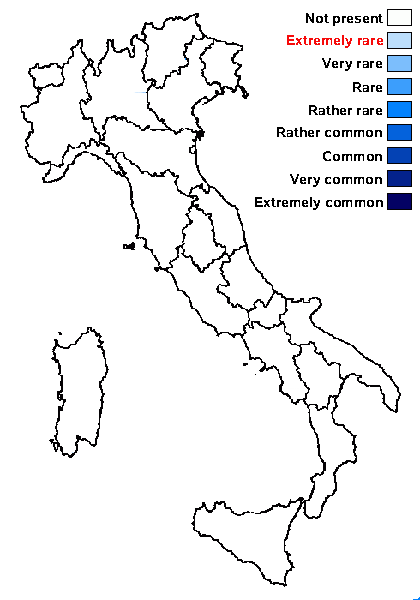Rinodina straussii J. Steiner
Ann. Mycol., 8, 2: 242, 1910
Synonyms: Kudratovia straussii (J. Steiner) S.Y. Kondr., Lőkös & Hur
Distribution:
Description: Thallus crustose, episubstratic, thick, areolate, the areoles flat, sometimes almost stalked, sublobate, up to 0.8-1.4 mm wide, chalky white to grey, dull or shiny. Apothecia lecanorine, adnate, up to 1 mm across, with a black, sometimes pruinose, flat to finally convex disc and an entire, persistent or rarely excluded thalline margin. Thalline exciple 80-120 µm wide laterally, corticate, the cortex 15-20 µm wide, with a 15-30 µm thick epinecral layer, without crystals; proper exciple colourless, 10-20 µm wide, expanding to 25-40 µm at periphery, without crystals; epithecium dark brown; hymenium colourless, 90-100 µm high, not inspersed with oil droplets; paraphyses 2.5-3 µm thick at mid-level, the apical cells 5-7 µm wide; hypothecium colourless, 80-130 µm high. Asci 8-spored, clavate, the K/I+ blue tholus penetrated by a faintly amyloid apical cushion with parallel or diverging flanks, the wall K/I-, surrounded by a K/I+ blue outer layer, Lecanora-type. Ascospores 1-septate, pigmented, broadly ellipsoid, (17.5-)20-22(-24) x (9.5-)11-12(-14) µm, with 2 darker bands over the cells, Bicincta-type, with a smooth wall, without a torus, with an ontogeny of type A (apical wall thickening after septum formation), the young spores often inflated at septum. Photobiont chlorococcoid. Spot tests: K-, C-, KC-, P-, UV-. Chemistry: without lichen substances.Note: a rare species growing under overhangs of calcareous rocks; widespread in Central Asia and North America, and also reported from a few sites in the Alps (Carinthia in Austria, Switzerland). To be looked for in the Italy, especially in the xerothermic Alpine valleys.
Growth form: Crustose
Substrata: rocks
Photobiont: green algae other than Trentepohlia
Reproductive strategy: mainly sexual
Subcontinental: restricted to areas with a dry-subcontinental climate (e.g. dry Alpine valleys, parts of Mediterranean Italy)
In underhangs rarely wetted by rain

Predictive model
Growth form: Crustose
Substrata: rocks
Photobiont: green algae other than Trentepohlia
Reproductive strategy: mainly sexual
Subcontinental: restricted to areas with a dry-subcontinental climate (e.g. dry Alpine valleys, parts of Mediterranean Italy)
In underhangs rarely wetted by rain

Predictive model
 Index Fungorum
Index Fungorum
 GBIF
GBIF

